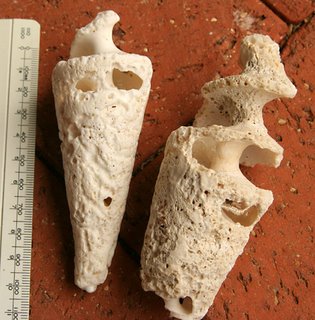 In an earlier post (Ring them bells), I talked about Campanile symbolicum, the last species left alive in the marine snail family Campanilidae. In the Tertiary, giant Campanile ploughed across the sandy floors of tropical oceans. Then the family declined, dwindled into extinction—except for C. symbolicum, which hung on in southern Australia.
In an earlier post (Ring them bells), I talked about Campanile symbolicum, the last species left alive in the marine snail family Campanilidae. In the Tertiary, giant Campanile ploughed across the sandy floors of tropical oceans. Then the family declined, dwindled into extinction—except for C. symbolicum, which hung on in southern Australia.Today, this big white snail is restricted to the SW corner of the continent, from Geraldton to the Recherche Archipelago. It is a secretive animal, feeding at night to avoid predators. Shells are often cast up on the beaches of the south west. Most are beach worn, like these specimens. But even the damaged ones tell a tale.

The two shells at the top show how the whorls are formed around a central axis or columella. The visceral mass—the part of the snail that contains the internal organs—coils up into those whorls. You can see how much body armour these animals wear. When something upsets the snail, a single muscle wrapped around the columella draws the animal back into its shell.
Those circular scars on the lower shell have been made by another snail. Limpets in the families Hipponicidae and Capulidae often live on the shells of larger molluscs. They attach so tightly that they wear down the host's shell. That makes a neat fit. (A bit like the depression on the sofa cushion.) While they mooch about on the larger snail, they feed on the poo it produces. Don't knock it. It's a living.
Many thanks to MM, who photographed these shells at glorious Margaret River, W.A.